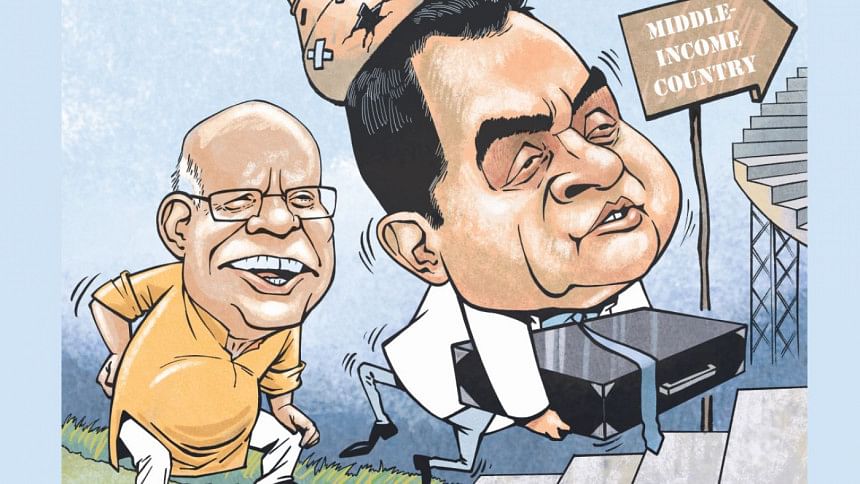Time to work on basics

The Bangladesh economy is taxiing for take-off -- for its long-haul flight to the developed country club, with couple of stopovers in between.
Last year it reached the boarding gate for the flight to the developing country club that lands in 2024. After a short transit it will continue with its onward journey, with another stopover at the higher middle-income country club in 2030.
If all goes well, it will reach its final destination in 2041. But the problem with long-haul flights with stopovers is that one is always open to missed connections -- that can set off a stressful domino effect.
Missed connections can be due to events out of one's control -- or it can be due to one's inattention. And it is this conundrum that the Bangladesh economy finds itself in at present.
Is the government taking adequate preparations for the arduous journey ahead; or is it just coasting along keeping its fingers crossed that the economy will get there somehow?
The actions of the Awami League-led government in recent years seem to suggest the latter. But, there is a fresh cabinet in the picture this year -- and a new finance minister, AHM Mustafa Kamal.
Is he a foresighted, smooth operator; or is he more of the same -- is what we find out today as he unveils his first national budget before parliament.
With a tottering banking industry, a disgruntled private sector, wanting revenue base, edgy external balance, rising inequality and a growing population of disillusioned youth -- the stage is set for him to announce himself as a clean break from the past.
His first task would be to fix the banking sector -- the heart of the economy -- which is afflicted with an unsustainable sum of default loans and errant disposition.
At the end of March, default loans zoomed past the psychological Tk 1 lakh crore-mark for the first time in Bangladesh's 48-year history.
Some Tk 16,962 crore of default loans were accrued in the first three months of 2019 -- the highest yet for a quarter -- to take the total to an eye-watering Tk 110,874 crore, according to data from the Bangladesh Bank.
That is the official line; if the loans that were rescheduled, written-off and caught in court stay orders are considered, the tally would be much higher.
And more than 52 percent of the default loans were with eight state-run banks, which the government has been recapitalising over the past decade with about Tk 17,500 crore of taxpayers' money -- unconditionally.
Word on the street is that Tk 1,500 crore would be set aside in the upcoming budget too for this end.
But here, Kamal can separate himself from his predecessor by tying the capital injection with a watertight performance agreement. And watertight is the operative word here.
His affirmative action does not just stop there: a banking commission must be formed to straighten out the sector and plug the loopholes in the Bank Company Act, Bankruptcy Act and the Money Loan Court Act.
The immediate past finance minister AMA Muhith danced around the issue and Kamal has spoken of the issue since taking office in January. But, he now has the chance to put his money where his mouth is.
This is the need of the hour as without a healthy banking sector there will not be any economic growth to be enjoyed in the future as it will at one point lose its capacity to mobilise resources to the private sector -- the blood supply of the economy.
Already, in April private sector credit growth sank to a 56-month low of 12.07 percent. And at the panoramic level, private investment to GDP has been languishing at the 22-23 percent mark for the longest time -- way lower than the requisite 32 percent to carry on the growth momentum.
The reasons are two-pronged: banks do not have enough funds to lend out to the private sector and on a broader level there are one too many bottlenecks for them to take the plunge with gusto.
The shackles for the business community are coming from land unavailability, poor logistics, plodding bureaucracy, skills shortage and quality energy scarcity.
And it is in this area that Kamal, a successful businessman, can be decisive.
To alleviate the land problem, the government has in the past announced creation of 100 economic zones, but their current status remains ambiguous.
To address the bureaucratic delays, it has passed an act in the parliament that would transform the Bangladesh Investment Development Authority into a one-stop shop for investors to set up factories. As of now, it just remains an idea.
For mitigating poor logistics and energy scarcity, the government did set in motion 14 mega infrastructural projects. But, none of them is on schedule.
And in the most worrying development, there is a brewing pandemic of skills mismatch.
Youths with academic certificates are sitting idle, while employers are complaining of not finding the right people for the job -- and often resorting to hiring from abroad.
In 2017, 5 lakh foreign workers were employed in Bangladesh is wide range of sectors. And they sent home about $5 billion, according to a study of the Centre of Excellence for Bangladesh Apparel Industry and Muhith.
More than 20.1 million youths aged 15-29 participated in the labour force, according to the Labour Force Survey 2016-17. Of them, 2.1 million were unemployed.
Then another 29.8 percent of the total 41.4 million 15-29 year-olds were not in education, employment or training; and 87 percent of them were females.
This also means Bangladesh is simply watching its bounty of demographic dividend pass it by.
Demographic dividend, as defined by the United Nations Population Fund, is the economic growth potential that can result when a country's population's age structure tilts more towards the working age of 15 to 64 than non-working age of 14 and younger and 65 and older.
By 2040, this window of opportunity for Bangladesh will shut firmly.
The government did come up with the National Skills Development Authority Act in 2017, but as with all things it is far from delivering.
With today's budget, Kamal can take a step in the right direction to addressing all these issues.
Does he give enough resources to the Bangladesh Economic Zones Authority and a definitive timeline to get the industrial parks ready? Does he provide enough for system development and interoperability to make the BIDA truly a one-stop shop?
Does he prioritise the mega projects that can yield immediate economic gains like the Padma bridge, Dhaka metro rail, Rooppur power plant, Hazrat Shahjalal International Airport expansion and the Dhaka Elevated Expressway and see through that the money is used efficiently?
For a change, does he put enough in the education and gender budgets to overhaul the academic system, retrain youths and get the females to join the labour force by removing social barriers for them?
But, it is all too tempting to spend one's problems away. The option though is not available to the government -- thanks to its weak revenue base, wobbly external balance and the ailing banking system.
Its tax to GDP ratio is amongst the very lowest in the world -- and has been for a good while now -- at less than 10 percent.
With the view to rectifying the situation, the government at the turn of the decade started working on a new law for value-added tax -- which typically accounts for about 38 percent of the National Board of Revenue's total collections.
The law centred on a single rate of 15 percent VAT was passed in the parliament in 2012. But, it was met with vehement protests from the business community, leading to delays in its implementation thrice.
It will finally take effect on July 1 -- but just in name. Giving in to populist urges, the government hammered out a VAT law that has five rates -- and a can of complications.
Whether Kamal has a plan in place to ensure the new VAT law is a success is what needs to be seen in his budget speech.
The government though has other weapons in its arsenal to mobilise more revenue: income tax and corporate tax.
There are 40 million in Bangladesh who are capable of paying income tax but only 1.5 million do so, according to Muhith.
There is an economic theory -- by the name of Laffer curve -- which suggests that sometimes cutting tax rates can increase total tax revenue. The government, perhaps, can deploy this for corporate tax, where the rates go as high as 47 percent.
But what is important is Kamal comes up with a plan to stop evasion and leakages from the system.
The government can borrow from domestic sources, but given the strained state of the banking system it would not be wise to pursue this lead too much. What remains then is the high-cost national savings certificates.
It can use foreign aid, a record amount of which is stuck in the pipeline. As of November last year, the amount stands at $48.75 billion.
But, given the deficit in the overall balance of payment for three years now a little caution would be wise.
With the constraints on resources, it is imperative then that Kamal stresses on good governance to make the most of what is at disposal. In short, making every penny count should be the focus at the end of the day.
Sound policies and governance, after all, were responsible for the astronomical growth of eight Asian economies -- Hong Kong, Indonesia, Japan, Malaysia, the Republic of Korea, Singapore, Taiwan (China) and Thailand -- from 1965 to 1990, prompting the World Bank to dub it the "East Asian Miracle".
"Their progress was phenomenal. In a single generation they had been able to transform the character of their economy. They were able to get rid of chronic poverty," former India Prime Minister Manmohan Singh once said about the eight countries.
This, after all, is where we aspire to be once we get off the long-haul flight at our final destination.

 For all latest news, follow The Daily Star's Google News channel.
For all latest news, follow The Daily Star's Google News channel. 








Comments